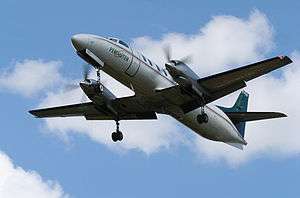Lockhart River air disaster
|
Fairchild Metroliner similar to VH-TFU | |
| Accident summary | |
|---|---|
| Date | 7 May 2005 |
| Summary | Controlled flight into terrain |
| Site |
11 km north-west of Lockhart River Airport 12°44′13″S 143°13′05″E / 12.737°S 143.218°E |
| Passengers | 13 |
| Crew | 2 |
| Fatalities | 15 (all) |
| Survivors | 0 |
| Aircraft type | Fairchild Swearingen SA227-DC Metro 23[1] |
| Operator | Aero-Tropics Air Services on behalf of Transair[1] |
| Registration | VH-TFU |
| Flight origin | Bamaga, Queensland |
| Destination | Lockhart River Airport |
The Lockhart River air disaster refers to the controlled flight into terrain (CFIT) in Queensland, Australia of a Fairchild Swearingen Metroliner commuter aircraft at 11:44 am on 7 May 2005. The aircraft, registered VH-TFU,[2] owned by Transair Ltd and operated by Aerotropics, was on approach to land at Lockhart River Airport in far-north Queensland, Australia when it struck the ridge known as South Pap, 6 nautical miles (11 km) north-west of the Airport.[3] All fifteen on board died as the aircraft was completely destroyed by impact forces and subsequent fire. The flight was returning from Bamaga on Cape York to the regional centre of Cairns. It was the worst air crash in Australia in 36 years since MacRobertson Miller Airlines Flight 1750 on 31 December 1968.[4]
Investigation
The Queensland Coroner's Inquest in 2007, found that, despite evidence that there were a number of issues leading up to the crash, pilot error was the prime cause. Families of those who lost their lives in the disaster have been highly critical of the Coroner's findings and the deficiencies in the operations of the regulator, the Civil Aviation Safety Authority (CASA), and the poor company structure and practices of Transair Ltd. As the Cockpit Voice Recorder was inoperable, and had been for some time, the events and conversations occurring between the flight crew will never be known.
Senate inquiry
As a result of intense lobbying by the father of one of the victims, Constable Sally Urquhart, and others, the Australian Senate's Rural and Regional Affairs and Transport Committee resolved to conduct an inquiry into the Civil Aviation Safety Authority, its operations and other matters. The Inquiry was convened on 2–3 July 2008 at Parliament House, Canberra. As well as Mr Shane Urquhart's submission, there were sixty others which were considered by the Inquiry. The vast majority of the submissions were highly critical of most aspects of CASA's operations. Several people and organisations, including Mr Urquhart, supported their submissions in person at the Inquiry. In September 2008, the Committee Chair, Senator Glenn Sterle, released the report of the inquiry to the Transport Minister Mr Anthony Albanese and the public.
The recommendations from the report are:
- 1. That the Australian Government strengthens CASA's governance framework and administrative capability by:
- a. introducing a small board of up to five members to provide enhanced oversight and strategic direction for CASA; and
- b. undertaking a review of CASA's funding arrangements to ensure CASA is equipped to deal with new regulatory challenges.
- 2. In accordance with the findings of the Hawke Taskforce, that CASA's Regulatory Reform Program be brought to a conclusion as quickly as possible to provide certainty to industry and to ensure CASA and industry are ready to address future safety challenges.
- 3. That the Australian National Audit Office audit CASA's implementation and administration of its Safety Management Systems approach.
Further incidents
Following the Lockhart River crash, Transair in Australia went into liquidation in late 2006.[5] Aerotropics also no longer operates because the Civil Aviation Safety Authority cancelled its AOC due to ongoing safety breaches. Transair continued to operate its PNG business until 31 August 2010 when the company's Cessna Citation ran off the runway on landing at Misima Island near Milne Bay, Papua New Guinea. The previous owner of Transair in Australia, Les Wright, died along with three others in the ensuing inferno. There was one survivor.
Notes
- 1 2 Accident history for VH-TFU at Aviation Safety Network
- ↑ "CASA Aircraft Register". Civil Aviation Safety Authority.
- ↑ "Aviation Occurrence Report 200501977 Final". Australian Transport Safety Bureau. 4 Apr 2007. Retrieved 2014-01-14.
- ↑ Ten Worst Air Crashes in Australia since 1968. Retrieved 2011-09-11
- ↑ Hans Mick (17 August 2007). "Lockhart River plane crash findings handed down". Australian Broadcasting Corporation. Retrieved 2014-01-14.
References
- Sydney Morning Herald
- Finding of Inquest: Inquest into the Aircraft Crash at Lockhart River. Office of the State Coroner 17 August 2007 Brisbane, Queensland
- Senate Committee Report: Rural and Regional Affairs and Transport. "Administration of the Civil Aviation Safety Authority (CASA) and related matters" September 2008
